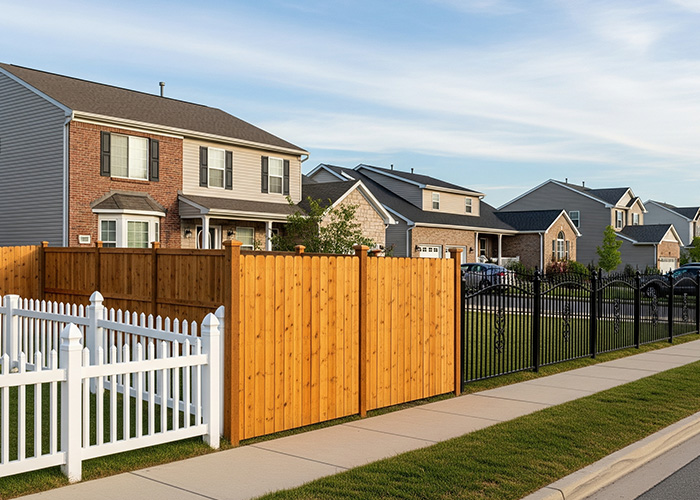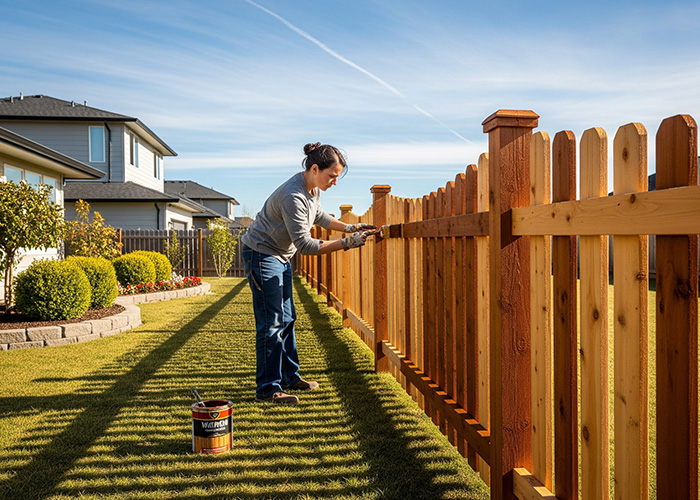Homeowners appreciate the privacy and curb appeal that a fence can bring. However, a fence that ignores community standards can lead to delays and fines. This guide explains how to follow HOA fence rules in Southern California, ensuring your project proceeds smoothly without any issues.
HOA Fence Rules in Southern California
Your association’s rules exist to keep a consistent look and to protect safety. Most communities require approval before you install, replace, or change a fence. This is true even if you pay for it yourself and build it on your lot.
Many owners ask why city approval is not enough. Local permits do not replace HOA fence rules in Southern California. Therefore, you must meet both sets of standards. City or county codes set the baseline for placement and safety, while your HOA adds style, color, and material limits that keep a cohesive look.
The HOA’s Authority

Authority comes from your governing documents. These include the CC&Rs, bylaws, and architectural HOA fence guidelines. In California, the Davis-Stirling Act supports this framework and requires associations to use a fair written procedure for architectural approvals.
For owners, this has two takeaways. First, they can submit a complete application so that the committee can make a decision within its timeline. If denied, they can use the steps to appeal found in your rules. As the board, you need to keep written records of your decisions.
Fence Height: City Rules Still Apply
Most Southern California cities limit fences in front yards more than in back yards. Many codes also treat fences and walls differently, with separate limits for each. If your lot is situated on a slope or near a street corner, additional rules may apply.
After you confirm local rules, match them with your community’s HOA fence height limits. If your city allows a taller fence but your HOA allows a shorter one, the HOA rule controls inside the community. When city rules are stricter than those of the HOA, the city rule takes precedence.
Common HOA Fence Restrictions to Expect

Most associations publish HOA fence restrictions that cover:
- Location: set back from sidewalks, corners, and utilities
- Height steps: lower toward streets, higher in rear yards
- Materials: approved options like wood, vinyl, wrought iron, or composite
- Colors: neutral tones that match trim or community palettes
- Style: open pickets vs privacy panels, caps, and post spacing
These standards usually appear in your community’s HOA rules on fences or in the architectural handbook. If your rules are silent, ask management to confirm past approvals. Prior examples help you choose a design that will pass.
How to Get Approval the First Time
Strong applications move faster under HOA fence rules. If you’re applying for approval, use these five items and make each one clear.
Site Plan
You should show property lines, easements, and setbacks with simple measurements. Trace the exact fence path, gate locations, and any slope changes so reviewers can see height transitions. You should also mark utilities and note corner sight lines if your lot faces a street.
Elevation and Specifications
When applying, include basic drawings that show fence height at each section, especially where the grade changes. List the material, color, finish, post size, post spacing, cap style, and picket or panel type. If a pool is nearby, state the self-closing hinges and latch height.
Photos
Provide clear photos of the area today from several angles, along with one or two nearby fences that the HOA has already approved. Add short labels so the committee can compare style and scale at a glance. Use at least one wide shot and one close shot for context.
Contractor Information
Share the installer’s license number and proof of insurance, and note experience with HOA projects. Provide a simple schedule for start and finish, along with the staging location for materials. Confirm work hours and cleanup so the board knows the job will be completed neatly and in compliance.
Neighbor Notice or Consent
If the fence sits on a boundary, include a brief letter or email from the neighbor acknowledging the plan. Note who will pay for what, when work will start, and how access will be handled. This keeps the review focused on design and compliance, not disputes.
The Good Neighbor Law

Many boundary fences are shared. California’s Good Neighbor Fence Act presumes adjoining owners share the reasonable costs to build, maintain, or replace a boundary fence. You must provide your neighbor with written notice that includes the scope, cost, and timing of the work before it begins.
Courts can reduce or waive a neighbor’s share if equal cost would be unjust. Keep photos, estimates, and your notice to support the project. Remember, cost sharing does not replace HOA fence rules. You still need HOA approval before work starts.
Enforcement, Hearings, and Fine Schedules
If the board believes a fence violates the rules, it must offer due process. The association must provide written notice before a hearing and then send a written decision after the meeting. Most associations use a published fine schedule, and many allow time for correction of a violation before fines are imposed.
If you receive a notice, respond promptly and request a hearing if necessary. Bring photos, approvals, and code notes that support your case. If you still disagree after the hearing, you may use the internal appeal or dispute resolution options outlined in your rules.
Practical Steps to Avoid Fence Fines

A bit of prep saves time and money. Try to create these habits to keep your project compliant.
- Read the CC&Rs, HOA fence guidelines, and any architectural forms.
- Confirm property lines, setbacks, and utility easements.
- Match nearby approved fences for style and color.
- Submit complete plans and keep copies of all documents.
- Wait for written approval before you order materials.
Special Situations to Monitor
Some fence projects may trigger extra rules, so review these situations carefully to avoid delays and fines.
Corner and Street-Facing Lots
Sight lines at corners matter for safety. Many codes require lower panels near intersections so drivers and walkers can see clearly. The HOA may also require open pickets or see-through iron near streets to keep a lighter look.
View Lots and Scenic Corridors
Some communities protect shared views. A solid fence along a ridge or trail may be restricted or stepped down in key spots. Expect the committee to ask for staggered heights, lattice accents, or open sections where the view is most sensitive.
Pools, Spas, and Safety Areas
Cities often require minimum heights, specific latch heights, and self-closing gates around pools and spas. Your HOA may also establish style and color standards in addition to these rules. Include the safety specs on your drawing so reviewers see that you meet both sets of requirements.
Hillsides and Retaining Walls
Height is measured differently when a fence is installed on a wall. Some cities count the combined height from the lower grade to the top of the fence. Others measure only the fence. Ask planning staff how they measure on your lot, then mirror that method in your plan so the HOA can verify the number.
Wildfire and Coastal Zones
In fire-prone areas, combustible materials are often limited near slopes or open spaces. In coastal areas, corrosion is a concern, so the HOA may require specific fasteners, coatings, or materials. If you live in these zones, bring a product sheet that shows compliance with the local standard.
Working With Your Community

Good communication prevents disputes. Talk with neighbors early, especially for boundary fences. Share drawings and sample photos. Ask if there are concerns about height, style, or gate location.
If you receive a violation letter, respond promptly and respectfully. Bring photos, prior approvals, and any city notes that support your plan. The board must give proper notice and a written decision. If you still disagree, follow the appeal or dispute resolution steps in your rules.
Budget, Timing, and Warranty Notes
When looking for people to build your fence, get at least two bids from licensed contractors. Ask about lead times for materials, especially if you need custom panels or powder-coated iron. If your HOA requires a refundable deposit, include the receipt with your packet. This avoids delays at the start of work.
Request a written warranty for both labor and materials. Keep a copy of the final approval with the warranty. If a board member or neighbor questions the fence years from now, you can demonstrate that the work adhered to the approved plan.
Maintenance Expectations After Installation

Approvals often include care standards. Keep posts straight, gates aligned, and finishes clean. Replace broken pickets quickly, and repaint faded sections before they become eyesores. A well-kept fence protects your property value and supports the community standard.
If a storm or tree damages your fence, take photos and submit a brief note to management. Most boards allow temporary bracing while you arrange repairs. If the fence is located on a boundary, notify your neighbor and agree on a timing before work begins.
How Management Can Help
Your community manager can provide current forms, fee schedules, and sample approvals. Managers also know the common reasons fence applications get denied. Ask for that list. It is often simple items, such as the wrong color, missing setbacks, or posts facing the street instead of the yard.
Managers can also point you to the proper city desk for permits. Permit guides and zoning handouts explain when extra approvals are needed for taller fences, front-yard fences, or fences on walls. Similar guides are available across Southern California, so please ask for the page that corresponds to your city.
Ensuring Compliance
Fences can enhance privacy and increase value when carefully planned. Learn the rules, follow the process, and document each step. With the proper prep, you can meet HOA fence rules and avoid fines.
Looking for professional support for architectural reviews? Personalized Property Management offers HOA management services around Southern California. Call us at 760-325-9500 or email us at info@ppminternet.com for more information!
Related Articles:
- HOA Disaster Preparedness Southern California: What Every Community Should Know
- Before Making Changes, Know The HOA Landscaping Maintenance Rules
- HOA Architectural Review Committee: Is It Fair And Effective?
